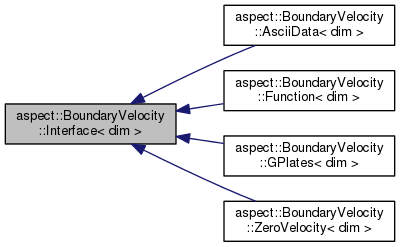 |
ASPECT
|
 |
ASPECT
|

Public Member Functions | |
| virtual Tensor< 1, dim > | boundary_velocity (const types::boundary_id boundary_indicator, const Point< dim > &position) const =0 |
 Public Member Functions inherited from aspect::Plugins::InterfaceBase Public Member Functions inherited from aspect::Plugins::InterfaceBase | |
| virtual | ~InterfaceBase ()=default |
| virtual void | initialize () |
| virtual void | update () |
| virtual void | parse_parameters (ParameterHandler &prm) |
| virtual void | save (std::map< std::string, std::string > &status_strings) const |
| virtual void | load (const std::map< std::string, std::string > &status_strings) |
Additional Inherited Members | |
 Static Public Member Functions inherited from aspect::Plugins::InterfaceBase Static Public Member Functions inherited from aspect::Plugins::InterfaceBase | |
| static void | declare_parameters (ParameterHandler &prm) |
A base class for parameterizations of velocity boundary conditions.
Definition at line 104 of file simulator_access.h.
|
pure virtual |
Return the velocity that is to hold at a particular position on the boundary of the domain.
| boundary_indicator | The boundary indicator of the part of the boundary of the domain on which the point is located at which we are requesting the velocity. |
| position | The position of the point at which we ask for the velocity. |
position. Implemented in aspect::BoundaryVelocity::GPlates< dim >, aspect::BoundaryVelocity::AsciiData< dim >, aspect::BoundaryVelocity::Function< dim >, and aspect::BoundaryVelocity::ZeroVelocity< dim >.